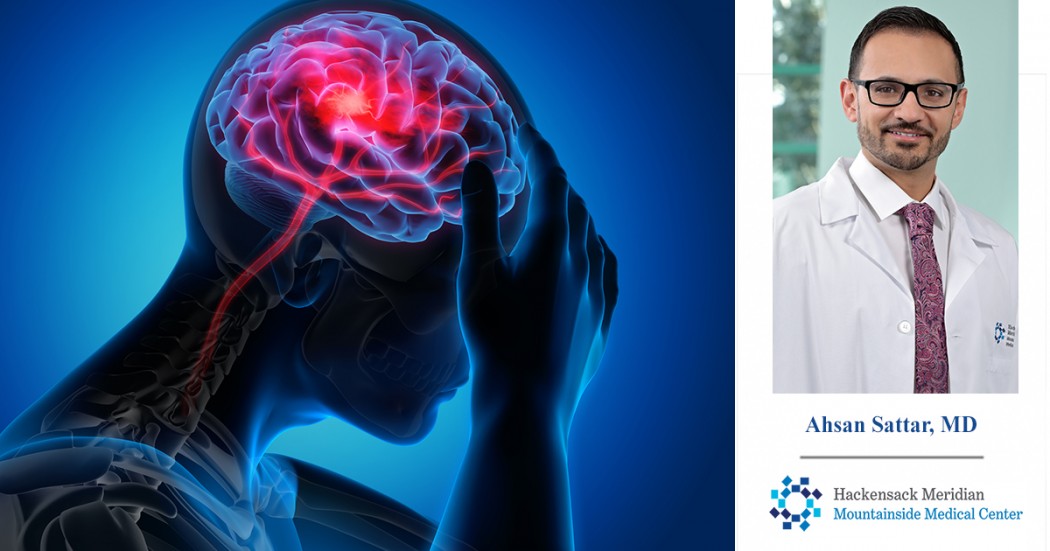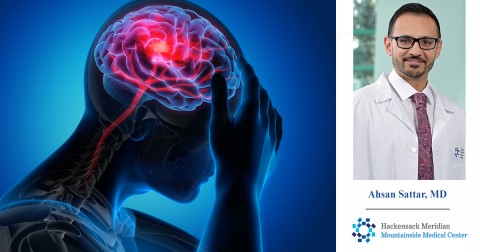Everyday tips for understanding and preventing a stroke

Every year, nearly 800,000 people in the U.S. suffer a stroke, with 75% suffering their first. Have you or a family member suffered a stroke? Do you want to learn more about identifying, treating and hopefully preventing one? Ahsan Sattar, MD, a board-certified neurosurgeon at Hackensack Meridian Mountainside Medical Center, answers some of the most common questions about strokes.
What are the main causes of a stroke?
A stroke is a neurological illness in which patients lose normal brain function. It can also be an acute illness, which means you can recover quickly, depending upon the patient and their baseline health level. Being overweight, having high blood pressure or having diabetes can potentially cause a stroke.
There are 2 major types of strokes: ischemic and hemorrhagic.
An ischemic stroke, called a clotting stroke, occurs when a blood clot forms somewhere in the body, makes its way to the brain and shuts down the blood supply to that area of the brain. The loss of blood in the brain creates a loss of neurological function. Approximately 85% percent of strokes that occur are ischemic strokes.
Hemorrhagic strokes, often called bleeding strokes, are less common. Blood forms in the brain from a vessel bursting, aneurysm rupture or other rare kinds of brain bleeds. A subarachnoid hemorrhage is also classified as a stroke. It occurs when a rupture takes place in the subarachnoid space in the brain.
A stroke can affect a number of neurological functions, including walking, talking and paralysis in the body. Ischemic strokes affect the sensory part of the brain. Lack of blood supply to any of these areas can have adverse effects.
What are the signs and symptoms of a stroke?
Stroke symptoms occur very suddenly. Signs of a stroke include the loss of normal neurological function such as:
- > Inability to see out of one or both eyes
- > Facial drooping
- > Weak arms/legs on one side of the body
- > Loss of balance
- > Speech is impaired
- > Seeing double
- > Sudden severe headache or “thunderclap headache,” which people often call “the worst headache of their life”
If you are exhibiting any of these symptoms and fear you may be having a stroke, call 9-1-1 immediately.
Is a stroke curable?
Yes. At Mountainside, we have neurologists and neuroendovascular specialists on call around the clock to treat patients who are having a stroke. Generally, stroke patients who are treated in a timely fashion can fully recover after 90 days. This changes with the severity of the stroke and is why timing is everything.
Can another illness be mistaken for a stroke?
Yes. Before we start treatment, it is imperative to rule out some of the biggest stroke mimics. One of the most common is any alteration in your blood sugar. Hypoglycemic episodes – when your blood sugar drops to dangerously low levels – exhibit similar symptoms to a stroke, such as a paralysis on one side of the body. A high blood sugar level can also generate symptoms similar to a stroke.
Bell’s palsy, a condition that suddenly causes muscle weakness on one side of the face, mimics stroke symptoms. If you experience facial drooping, is important that you still visit a physician to rule out a stroke.
What is the most severe type of stroke?
It all depends on where the stroke is happening in the brain, along with how quickly the stroke can be identified and treated. If a stroke affects a very small branch of the brain, you are more likely to have a full recovery. A clot formed in a larger area of the brain, where an entire hemisphere is in jeopardy, can result in a debilitating stroke for most patients.
Can a stroke happen again?
Yes. Once you have a stroke, there is a higher chance of having another stroke. After a stroke, secondary stroke prevention is key to reducing a patient’s risk level. Your physician should do a number of tests to examine if you are at risk for a second stroke.
How is a stroke treated?
A stroke can be treated in different ways. One treatment is an injection of tPA (alteplase) within 4.5 hours of a stroke. This medication dissolves blood clots and allows blood to flow back into the brain as fast as possible.
Some patients can also be candidates for a procedure called mechanical thrombectomy. In this procedure, a small tube is inserted into the patient’s artery either from the groin or the hand. After reaching the clot in the brain, a small device at the end of the wire removes the clot and allows blood to flow freely again.
Why do you think more people are having strokes, especially younger people?
Our individual diet and lifestyle have a huge influence on our health. Inactivity, stress, being overweight and other lifestyle choices can promote plaque growth in the body’s vascular system and increase the risk of stroke.
Another rare cause that is more commonly seen in the young is arterial dissection. I have seen patients who come in with severe neck pain and stroke-like symptoms. They usually occur after physical trauma to the neck or sudden neck movements.
Younger people in this generation put a lot of emphasis on self-care, so they seek out massages or chiropractic care. However, it is wise to be careful when getting aggressive massages or when seeing a chiropractor. Be sure to get a referral from your physician.
Is it true that patients who have migraines with an aura are more prone to strokes?
Yes. There is a slight increase in stroke cases in patients who display this type of migraine. The medical community is still working on trying to find the root cause of why migraines happen, but we know that there is a vascular component. Patients who have suffered a stroke, a ruptured aneurysm or bleeding in the brain will often report headaches or migraines.
Is there a correlation between COVID-19 and a higher risk for stroke?
COVID-19 has caused blood clotting in patients’ veins whereas a stroke is an arterial disease in which a blood clot forms and blocks the arteries. If someone develops COVID-19 and develops any type of clotting, it is possible that the clot could make its way to the brain.
If I have a family history of brain aneurysms, should I be screened?
While it is important that you are screened, if you don’t have any common risk factors it lessens the risk of an aneurysm occurring. Screening is done by an MRI scan to look for aneurysms in the brain that haven’t ruptured.
What led you to choose neuroendovascular as your specialty?
A stroke can be worse than that, especially if you are nursing homebound and have a horrible quality of life. During residency a few patients get back to normal after undergoing mechanical thrombectomy. Helping restore a patient’s ability to walk and speak is almost instant gratification.
When should someone seek the care of a neuro/neuroendovascular surgeon?
Patients are often referred to me by their primary care doctor or neurologist. Any blood vessel-related problem that occurs in the brain, neck or spinal cord such as brain aneurysms, arteriovenous malformations is a reason to seek care from a neuroendovascular surgeon. Narrowing blood vessels due to plaque buildup and brain aneurysms are some of the most common examples.
What is the best way to prevent a stroke?
For someone who has never had a stroke, the best way to prevent one is to take care of your health.
Being a smoker is one of the biggest vascular risk factors for stroke. If you have diabetes, you want to make sure your blood sugar levels are very well controlled, along with maintaining a healthy diet.
Exercise is also key to maintaining good health. Patients with high blood pressure should make sure their blood pressure is no higher than 130. Those with an abnormal heart rhythm need to be sure they are under the care of a cardiologist who will appropriately monitor for any changes in their heart rhythm.
If you are exhibiting signs and symptoms of a stroke, call 9-1-1 immediately. For more information about the Advanced Stroke Program at Hackensack Meridian Medical Center, visit our webpage.





